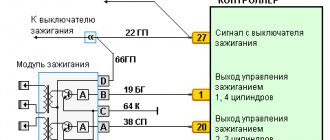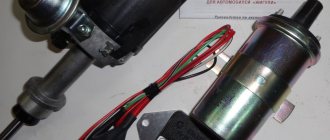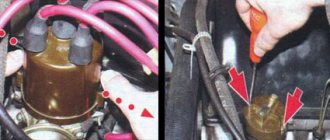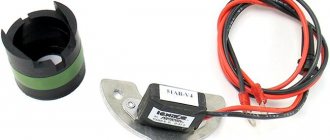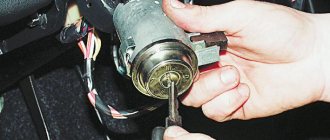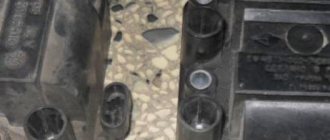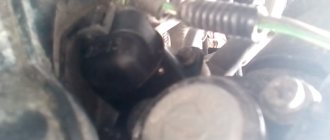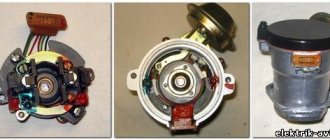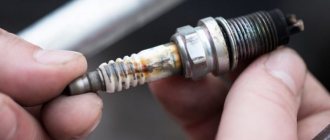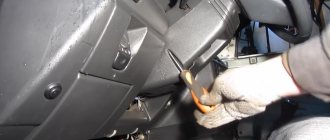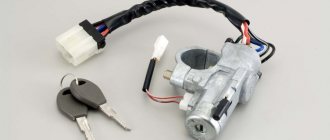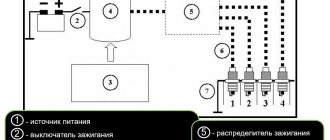Determination of early or late ignition
The stability of the engine, its power, fuel efficiency, etc. directly depend on the correct settings and uninterrupted operation of the ignition system.
Normally, on four-stroke engines, the fuel-air mixture should ignite at the end of the compression stroke, that is, just before the piston rises to top dead center. This ignition timing is due to the fact that the mixture requires a certain time to burn, after which the energy of the expanding gases pushes the piston down and the power stroke begins. By late or early ignition we mean a delay or advance in the operation of the ignition system in relation to the position of the piston in the cylinder. In other words, a spark from the spark plug is formed and ignites the fuel-air mixture not at the optimal moment when the piston approaches TDC, but earlier or later than this moment. This phenomenon is called early or late ignition. For this reason, owners of vehicles that have the ability to independently adjust the ignition timing (ignition timing) are often faced with the need to adjust the ignition.
Read in this article
Adjustment recommendations
The simplest way to adjust the ignition timing is to connect a 12-volt car light bulb to the high-voltage coil circuit. How to make the adjustment:
- When turning the crankshaft, align the mark on the pulley with the mark on the cylinder block. Remove the distributor cap and check the position of the slider - it should point to the contact of the first cylinder.
- Find the wire leading from the distributor to the high-voltage coil. Connect a light bulb to this contact, and connect its base to the ground of the car.
- Loosen the nut pressing the distributor body and turn on the ignition (the light will light up).
- Slowly turning the distributor housing, catch the moment when the lamp goes out. Tighten the nut.
Note. For the system to operate correctly, the spark must jump before the piston reaches TDC. The advance is 2–5 degrees of crankshaft rotation angle.
The question of which ignition is better - late or early - is incorrect from the very beginning. The moment of ignition of the fuel must be optimal. If necessary and there are no diagnostic instruments, the adjustment is made “by ear”: with the engine idling, the nut is released and the distributor is slowly turned by hand. Having caught the moment of the most stable operation of the engine, tighten the nut and press the gas several times to provoke popping or detonation. When you hear one of the signs, turn the distributor 1–2° in the desired direction.
The power, efficiency and overall quality of the engine depend on how well the ignition system works. Taking into account the fact that the fuel-air mixture takes some time to burn, normally its ignition occurs at the end of the compression stroke, i.e. before the piston rises to top dead center. However, there are times when the spark plug spark ignites the working mixture not at the optimal moment, but earlier or later. This is called early or late ignition.
Common signs indicating early or late ignition
- difficulty starting the engine
- increase in fuel consumption
- the appearance of popping sounds that emit into the exhaust system, carburetor, etc.
- drop in engine power and response
- unstable operation in idle mode
- deterioration in response when pressing the gas
- engine overheating and detonation
Early ignition is indicated by:
- metallic ringing sound in the cylinder block area
- floating idle speed
- unstable operation of the internal combustion engine
- pause after pressing the gas pedal
Late ignition is indicated by:
- loss of engine power
- significant increase in fuel consumption
- engine coking
- unit overheating
It is highly not recommended to drive a car with a broken ignition timing, because... this can lead to serious engine damage. Therefore, if your car has the ability to independently adjust the OZ, be sure to periodically adjust the ignition.
How to set the ignition timing?
Most often, a strobe is used for these purposes, but if there is no device, they resort to a control light. In any case, the adjustment is carried out at idle, at speeds of 850-900 rpm. The ignition timing angle ranges from -1 to +1 degrees relative to top dead center.
If you set the ignition using a strobe, you need to:
- warm up the engine until it reaches operating temperature
- connect the device to the on-board network
- Unscrew the nut of the ignition distributor-interrupter cover
- put the alarm sensor on the high-voltage wire of the first cylinder
- remove and plug the vacuum corrector hose (if equipped)
- direct the strobe light to the crankshaft pulley
- start the engine (work on XX)
- turn the distributor housing
- fix the body of the breaker-distributor so that the mark on the pulley coincides with the corresponding mark on the timing belt
- tighten the fixing nut
If you adjust the ignition using a control light, you need to:
- Turn the crankshaft so that the mark on its pulley coincides with the mark on the timing cover. In this case, the slider on the ignition distributor should point to the spark plug wire of the first cylinder
- loosen the distributor nut
- Connect one wire of the light bulb to the wire that goes from the distributor to the ignition coil, set the second to ground
- turn on the ignition and rotate the distributor body clockwise until the warning lamp stops lighting
- Carefully turn the distributor body counterclockwise. The task is to determine the position in which the light bulb lights up. In this position, fix the distributor body by tightening the distributor nut.
The adjustment steps described above apply to carburetor engines. If it concerns the injector, then without the intervention of specialists it is unlikely that the problem will be solved. The fact is that everything on the injector depends on the electronics, and the electronic control unit is responsible for the operation of the ignition and injection systems. To eliminate errors and failures, you need to reflash the “brains” of the car, which requires special equipment, certain skills and experience.
How to understand that the ignition is late or early
Ignition of the working mixture of fuel and air in the cylinders with advance or delay leads to certain malfunctions in the operation of the engine. The list of main signs by which you can identify an incorrectly installed ignition includes:
- difficulty starting the engine;
- noticeable increase in fuel consumption;
- the engine loses throttle response, power drops;
- unstable operation in idle mode is noted;
- responsiveness to pressing the gas pedal disappears;
- engine overheating and detonation occur;
An incorrect ignition angle can manifest itself in the form of characteristic pops that are heard in the exhaust system, carburetor, etc. It is quite obvious that further operation of an internal combustion engine with a broken ignition timing can lead to more serious engine damage, especially if persistent detonation occurs.
Consequences of an incorrectly set ignition angle
Both late and early ignition negatively affects the operation and service life of the engine. It should be added that not only power and fuel consumption depend on the correct ignition timing. If a spark on the spark plug forms earlier than expected, then the pressure of the expanding gases begins to counteract the piston rising to TDC (pre-ignition). Ignition of the working mixture after the piston has begun to move down from TDC leads to the fact that the released fuel energy “catches up” with the piston and enters the exhaust, rather than doing useful work (late ignition).
Signs of early ignition appear in the form of the following symptoms:
- the appearance of a metallic ringing sound during engine operation, which is localized in the area of the cylinder block;
- idle speed fluctuates, the engine is unstable;
- after pressing the “gas” there is a pause, the engine does not “pull” and overuses fuel;
Late ignition also causes significant damage to the engine. In this case, combustion of the mixture occurs under conditions of decreased pressure and increased volume in the internal combustion engine cylinder. The combustion process of the fuel-air mixture itself is disrupted, which burns out during the working stroke of the piston. As a result, signs of late ignition are:
- the engine loses power, you need to press hard on the gas to accelerate;
- there is a significant increase in fuel consumption;
- the engine is heavily coked by deposits and carbon deposits;
- improper combustion of the mixture leads to engine overheating;
Ignition timing
The moment of ignition itself determines the response time of the start system of the power unit. This term implies the required period of time during which the compressed combustible mixture is ignited by a spark discharge.
This moment is determined by a certain position of the crankshaft, when the ignition pulse arrives at the spark plug relative to TDC (the so-called top dead center), expressed in degrees. A certain period of time is required for complete combustion of the mixture in the short circuit. The speed of ignition propagation along the flammable front is 20-30 meters per second. The efficiency of ignition timing mainly depends on the location of the piston. If ignition of the mixture occurs when it is at TDC, ignition of the working medium will be partially realized during the expansion stroke, and partly during the exhaust. In this case, the piston does not receive the necessary pressure force, which in total reduces the effectiveness of the entire function. Because of this, when adjusting the ignition timing, it must be adjusted so that the force of gas pressure affects the TDC of the mechanism.
Setting the ignition timing yourself
Correctly set ignition timing requires adjustment of the OZ. It is necessary to adjust the ignition angle at idle speed. It should be taken into account that the optimal idle speed is considered to be in the range of 850-900 rpm. The ignition timing angle is also within a certain range from -1 (negative) to +1 (positive) degrees. The degree indicated is the degree relative to TDC.
The specified lamp is connected to the positive terminal on the ignition distributor, and is also connected to ground. Next, we will look at the main available methods for setting the ignition using the following example of a domestic “classic”:
Setting up strobe ignition
- the engine must be warmed up until it reaches operating temperature;
- The strobe light is connected to the on-board network;
- unscrew the fixing nut of the ignition distributor-interrupter cover;
- the alarm signal sensor is placed on the high-voltage wire of the first cylinder;
- if there is a vacuum corrector hose, you will need to remove and plug the specified hose;
- the strobe light is directed to the crankshaft pulley;
- the engine starts and idles;
- the distributor body is rotated;
- the position of the breaker-distributor body is fixed so that the pulley mark coincides with the corresponding mark on the timing belt;
- after aligning the marks, the fixing nut is tightened;
Setting the OZ according to the control light
If you use the light bulb ignition method, then you need to turn the engine crankshaft so that the mark on the crankshaft pulley matches the mark on the timing cover. In this case, the slider on the ignition distributor should point to the spark plug wire of the first cylinder.
Next, the distributor lock nut is loosened, after which one wire from the light bulb is connected to the wire that goes to the ignition coil from the distributor. The second wire from the lamp is installed to ground. Then you need to turn on the ignition and rotate the distributor body clockwise until the control lamp stops lighting. After this, you should carefully turn the distributor body back, that is, counterclockwise. Having determined the position at which the light bulb lights up, it is necessary to fix the distributor body in this position. Fixation is done by tightening the distributor nut.
Diagnosis of MH
Every driver can check whether the ignition timing is set correctly. He needs to drive onto a flat section of the highway, accelerate to an average speed (40-50 km/h) and, using fourth speed, sharply press the accelerator pedal to the floor.
- Detonation occurred, and then passed after a couple of seconds - the ignition timing was set correctly.
- The detonation did not go away after a couple of seconds, it occurred over a long period of time - the ignition timing is early, adjustment is required.
- There was no detonation at all - the ignition timing was set late and adjustment was needed.
How to properly adjust the ignition
However, experts recommend compliance with the MH using special measuring instruments - a strobe light, a test measuring light, etc.
We recommend purchasing a domestic model of strobe light - Orion ST-02. This one is inexpensive, and in addition to its direct tasks, it makes it possible to measure battery voltage and the number of revolutions of the power plant.
How to adjust electronic ignition
It is not difficult to connect the device; it is enough to integrate the positive and negative terminals of the strobe with the battery, and attach a special pin to the armored wire of the 1st cylinder. It is recommended to insert the speed controller wire into the diagnostic connector - contact IG (for Mazda vehicles).
Next, the device sets the mode for a specific engine. For example, for the Mazda 323F it is a four-stroke mode with a distributor. The best option for correctly displaying the number of revolutions.
Then the strip with marks on the engine is cleaned, you can even update the marks with white sealant so that it is better visible.
Pulley mark
The power unit warms up until the cooling fan operates. After this, the contacts in the diagnostic connector are closed - GND and TEN.
The speed is set according to the technical characteristics of the engine. For dohc – 12 degrees before TDC at 900 rpm, for sohc – 7 degrees before TDC at 1025 rpm.
The revolutions must correspond to the standard values. If not, adjust them with the screw on the throttle valve. After this, the marks on the pulley and the position of the runner are checked. Then the speed is checked again, if it is off, it is adjusted again. Next, you need to check the speed also with the jumper removed. If, at any position of the distributor, the revolutions remain at the same values, then these are the recommended, standard values.
Other methods of setting up and checking the ignition on a car
You can also set the ignition to spark or independently select the angle when the engine will operate most stably and smoothly. The simplest and least accurate method is to install based on the operation of the motor. To set up, start the engine, after which the nut securing the distributor housing is loosened. Next, you will need to turn the distributor housing clockwise and counterclockwise, finding the position at which the engine runs smoothly and the XX speed is the highest. After this, you should turn the breaker body a couple of degrees clockwise and tighten the distributor nut.
Then the wire contact should be placed near ground (distance about 5 mm) and turn on the ignition. After this, the breaker body should be rotated 20 degrees clockwise. Now the housing needs to be rotated back until a spark appears between the ground and the wire contact. In this position, the distributor body must be secured with the breaker fastening nut.
Upon completion, it is necessary to check the correctness of the OZ in motion. With a warm engine, the car should be accelerated to 40-45 km/h, after which fourth gear is engaged and the gas pedal is fully pressed. Next, it is necessary to assess the degree of detonation. It is considered normal when, immediately after engaging 4th gear, detonation is briefly present (2-3 seconds), but disappears as the car accelerates. If detonation continues after acceleration, then the likelihood of pre-ignition is high. If there is no detonation when the 4th gear is engaged, then the ignition is delayed. In such cases, the SOP adjustment should be repeated to obtain an optimal result.
Checking the ignition timing
Setting the required ignition timing is undoubtedly an important point in the overall operation of the car, which ensures that all the most important characteristics are normal: fuel consumption, power, idle speed, throttle response, etc. Therefore, it is very important to monitor this indicator by regularly checking the torque. Moreover, it is advisable to carry out this procedure every time the car is serviced.
You can determine whether the described indicator is set correctly using two tools: a test lamp and a strobe light.
So, you should check using a test lamp according to the following instructions:
- Connect the device to the capacitor in parallel.
- Using the starting handle, rotate the crankshaft until the spacer plate on the rotor is as close as possible to the contact on the distributor cap, which is also connected to the spark plug of the first cylinder.
- Turn on the ignition.
- Turn the crankshaft slowly until the light comes on.
- The labels should match at this point. If the lamp starts to burn before the marks match, or after, then this is a sure sign of an incorrectly installed ignition.
You can check the analyzed indicator using a strobe by following these points:
- Connect the device to the car's ignition system.
- Start the engine, at the same time setting the crankshaft speed to about 900 rpm.
- Direct the light of a flashing strobe lamp onto the crankshaft pulley so that it also illuminates the marks.
- Due to the fact that the light of the lamp appears synchronously with the flashing of a spark between the electrodes of the spark plug from the first cylinder, the mark on the pulley appears motionless. If the moment is set correctly, then all marks will coincide. But if they shift, then it is necessary to ensure that they coincide by rotating the distributor body.
You can also use this technique to check: drive out onto a flat road, accelerate the car well and drive in fourth gear at a speed of about 50 km/h. After this, press the brakes sharply and all the way. If this action causes small, short-term detonation sounds from the engine, then this is a sign of correct ignition timing. If the sounds are too strong, then this is early ignition; if they are absent at all, then it is later.
As part of this, I also recommend familiarizing yourself with the signs of an incorrectly installed ignition, which will help prevent uneven engine operation:
- Starting problems.
- Increased fuel consumption.
- Reduced throttle response and power.
- Unstable idle.
- Failure when pressing the gas.
- Overheat.
- Shots into the carburetor or muffler.
- Detonation.
Which ignition is better: early or late: what are the consequences?
The issue of vehicle performance is particularly acute at some moments. Everyone knows situations when the iron horse fails at the most inopportune moment. Because of this, serious troubles can arise, so you should constantly monitor the condition of the car so that it does not fail at a crucial moment. The main element in a car is the engine, so its operation must be monitored first.
The importance of correct ignition adjustment
The fidelity of the set ignition on carburetor engines is carried out using a strobe light
The quality and efficiency of engine operation depends on the nature of the ignition installation . Therefore, it is the installation of the ignition that is an important action that allows you to configure the power unit. If the ignition is installed incorrectly, both in the direction of increasing the advance angle and in the direction of decreasing it, the engine immediately feels a negative impact.
That is why setting the ignition timing should be approached responsibly and very carefully.
Ignition operating principle
A gasoline engine has certain factors that affect the quality and timing of the spark required to ignite the combustible mixture. These factors are combined into a separate mechanism called a distributor; it is also sometimes called a distributor-breaker.
Classic ignition circuit
It is installed in the area of the cylinder block; the distributor shaft is driven by the engine camshaft. There are cams located on the distributor shaft, they open the circuit at the required moment, and then a spark is formed.
The main disadvantage of the distributor is its tendency to mechanical wear, as a result of which the quality changes, as well as the timing of the spark..
Of course, this affects the performance of the engine, which will require further intervention and adjustment.
Early or late ignition, which is better?
The required ignition timing is certainly an important factor that affects the overall performance of the car. This indicator regulates the overall performance of the car. Many people are interested in which ignition option is better: late or early. The answer is surprising, since none of the proposed options is correct.
The optimal ignition mode is considered the best for the engine.
With it, the motor will not feel high loads. Extreme late and early options will certainly bring the car owner many problems with the technical condition of the vehicle. However, everything has its own nuances, in this case they need to be considered in more detail.
Signs of early ignition
- unusual sounds from the engine that appear due to increased wear;
- increased detonation;
- insufficient power, especially noticeable at low speeds.
Signs of late ignition
- poor starting quality, which is very harmful to the battery;
- increased fuel consumption;
- loss in power;
- The engine temperature increases much higher than normal.
As you can see, both in the first case and in the second, there are few pleasant moments. Despite this, many car owners (especially domestically produced cars) choose a later ignition when warming up the engine and at the start. Some perform early ignition, but in this case the power will drop significantly at low speeds.
Car with HBO
The main reason for installing gas equipment is to save on fuel. Practice shows that gas costs are approximately half that of gasoline, which is a compelling argument for many. However, you cannot completely switch to this type of fuel, since the need for gasoline remains for warming up and working at high loads.
HBO cylinder in spare tire
Plus, gas is consumed much faster and has a fairly high octane number, so the fuel-air mixture burns out even at the exhaust stage, which has a negative thermal effect on the exhaust tract.
Adjusting the ignition and combustion of the mixture on cars with LPG is the main task; good tuning allows you to save even more money on fuel.
Diesel car
Many symptoms of incorrect operation on gasoline cars are also transferred to diesel. The main difference between these two cars is the method of ignition of the fuel. Ignition of diesel fuel occurs due to close contact of the fuel with compressed, hot air.
Adjustment on a diesel engine
Ignition tuning on diesel cars consists of finding the required advance angle for diesel fuel injection; it must be supplied specifically at the peak compression moment.
If the angle is set incorrectly, the injection will be untimely. This will lead to poor-quality combustion of the mixture, and the engine will not operate properly.
Early ignition, signs, causes
Pre-ignition is one of the most common malfunctions of the ignition system of carburetor engines.
Its essence lies in too early (sooner than required for normal engine operation) ignition of the fuel in the combustion chambers (much earlier than the piston reaches top dead center). The initial ignition timing for a specific gasoline is set when the car engine is idling. This advance is necessary for proper engine operation. When it operates under load, even greater ignition timing is required, which is achieved through the operation of centrifugal and vacuum ignition timing regulators. But, if the initial angle is set too early, then the work of the regulators is superimposed on this incorrect angle, making the ignition so early that it leads to big problems in the engine.
Signs of early ignition
Depending on how much the ignition timing has deviated from the norm, signs of early ignition are either practically invisible or visible to the naked eye.
— Problem with starting the engine. The engine does not start the first or second time. There may be reverse rotation of the crankshaft after turning off the ignition.
— The car engine is idling unsteadily. It is impossible to equalize the XX speed with the screws on the carburetor, or the engine runs stably only when the speed is set to higher.
— Sluggish car dynamics at speed. At the same time, starting and accelerating can be quite acceptable, but at speed the engine’s power and throttle response are insufficient (“it’s as if someone is holding the car from behind”).
- “Fingers are knocking.” Constant detonation (fractional, chattering sound from the engine) when the car is moving, increasing when the gas pedal is pressed and does not disappear after it is released.
— The spark plugs are black. Poorly burning fuel deposits black soot on the spark plugs, leading to their rapid failure.
Signs of incorrect MH
How to set ignition timing
Signs of an incorrectly set ignition are the following:
- Difficulty starting the engine;
- The car loses part of its power;
- Loss of acceleration when pressing the accelerator pedal;
- Overheating of various systems in the car;
- Silencer shots;
- Detonation, threatening to result in a major overhaul of the internal combustion engine.
Signs of early ignition
Signs of early ignition
What is early ignition
Pre-ignition is a term that refers to the ignition of the fuel mixture in the cylinders of a car engine before the piston reaches top dead center on the compression stroke. Early ignition is essential for engine operation. It allows you to burn the fuel mixture most completely and efficiently and get the maximum return from this process, which is expressed in power, throttle response and speed.
In the ignition system of a carburetor car engine, in addition to the initially set early ignition timing (0-5 degrees), there are several devices that allow you to automatically make the timing earlier depending on the increase in engine load (for example, centrifugal and vacuum ignition timing regulators).
In the ignition system of an injection engine, determining the optimal ignition timing when the car engine is running is “managed” by the electronic control unit (ECU) of the engine control system. He calculates how much earlier to set the ignition based on data received from sensors (DPKV, DS, etc.).
If some problems arise in the operation of the car engine, ignition too early can be considered a malfunction. Next, we’ll figure out how to independently understand whether the ignition is too early (we diagnose a malfunction) or not.
Symptoms: Ignition too early
Several signs, when they appear, make sense to check the ignition timing and the operation of the devices responsible for increasing or decreasing it.
- The engine starts with difficulty or does not start at all
It is even possible for the crankshaft to rotate in reverse after turning off the ignition.
- Unstable engine idle speed
On a carburetor engine, the idle speed may not be adjustable with the carburetor adjusting screws.
- Sluggish acceleration and vehicle dynamics in motion
At the same time, starting and accelerating can be quite acceptable, but at speed the engine’s power and throttle response are insufficient (“it’s as if someone is holding the car from behind”).
- Engine detonation (“knocking” fingers)
Constant detonation (fractional, chattering sound from the engine) when the car is moving, increasing when the gas pedal is pressed and does not disappear after it is released.
- “Shoots” at the muffler when the engine is idling
Unburned fuel burns out in the muffler with pops. Misfires due to spark plugs working once.
- Black smoke from muffler when idling
Increased smoke from the muffler caused by combustion of fuel residues in the exhaust tract.
- Black carbon deposits on spark plugs
In which the spark plugs periodically fail.
- Increased fuel consumption by a car engine
The engine has to expend more energy to overcome the negative effects of early ignition, so fuel consumption can increase significantly.
Notes and additions
- To independently eliminate the malfunction - early ignition, on a carburetor engine you will first have to check the correct setting of the initial ignition timing, and secondly, check the serviceability and operation of the vacuum and centrifugal ignition timing regulators in the distributor of the car's ignition system. Thirdly, check the serviceability of the ignition distributor itself (distributor). We’ll figure out how to do this ourselves in our future publications on the channel.
— On an injection engine, determining and adjusting the ignition timing simply cannot be done. Special diagnostic equipment is required.
Test method while the vehicle is moving
The ignition timing is set correctly if, when the car is moving on a flat road at a speed of 45-50 km/h, pressing the gas hard to the limit causes minor and short-lived detonation knocks in the engine. The absence of knocking indicates late ignition.
In this case, it is necessary to loosen the fastening of the distributor on the engine and turn it by hand against the direction of rotation of the rotor by one or two divisions of the octane-corrector scale in the direction of advance (+), and in case of strong detonation knocks indicating early ignition, turn it in the direction of rotation of the cam in lag side (-). By adjusting the ignition setting, you should achieve stable operation of the car engine, and then re-fasten the distributor housing to the engine.
Early or late ignition
Ignition of the mixture in the working chambers of the cylinders too early or too late causes poor performance of the internal combustion engine. The engine may not pull uphill, accelerate slowly, vibrate strongly, etc.
Signs of an incorrectly set ignition:
- the engine starts with difficulty;
- increased fuel consumption;
- the motor cannot develop power;
- in idle mode (idle speed), the internal combustion engine either stalls or over-gasses;
- the engine responds poorly to pressing the gas pedal;
- The internal combustion engine overheats;
- the engine detonates.
You can easily determine that the ignition needs to be adjusted if you hear popping sounds from the muffler and the car “sneezes.” It is recommended not to operate the machine in this mode, but to adjust it immediately. Moreover, one of the signs is detonation, which can destroy valves, pistons and cylinders.
If the ignition is set incorrectly
If the ignition is early, it is because the spark appears early. At the moment when the piston just began to rise, the fuel-air mixture ignited and this explosion goes against the rising piston, resulting in a waste of energy.
Because the gasoline mixture ignites early, the piston experiences a greater force against its movement. This reduces the life of the crankshaft, pistons, connecting rod and pins.
The signs of early ignition can be determined by the following points:
- During operation of the internal combustion engine, a metallic noise appears, as if something is hitting the cylinder.
- The idle speed fluctuates and there is instability.
- If you press the gas sharply, the engine seems to choke and does not immediately respond to the supply of more fuel.
As for the installed late ignition, it also negatively affects the performance of the engine and the service life of its component parts.
In this case, the mixture is ignited late, that is, when the piston is already going down. The fuel burns out, if it has time, when the piston moves back (up).
Signs of late ignition:
- The internal combustion engine cannot reach speed. Reacts poorly to pressing the accelerator pedal.
- Fuel consumption is higher than normal.
- Carbon deposits and coke form on the piston and cylinder walls, which then, even with the ignition set correctly, interferes with operation.
- Due to uneven combustion of the fuel-air mixture, the internal combustion engine quickly overheats.
What is the difference between LSPI and detonation?
The knocking or ringing noise that many people recognize from classic cars is also uncontrolled fuel combustion. This is why many mechanics equate low-speed pre-ignition with detonation.
However, both phenomena differ in some nuances:
- Detonation is mainly recognized by a characteristic engine clatter and is usually prevented by a knock control system (it shifts the ignition timing to a later date). LSPI is often not perceived acoustically by drivers because it occurs very unevenly. It also cannot be avoided by moving the ignition timing;
- Unlike detonation, LSPI does not occur at high speeds, but at lower speed ranges and rpms. Additionally, pre-ignition usually occurs when the engine is cold;
- LSPI usually has a much stronger effect on the engine than detonation. With this phenomenon, on powerful small cars, a seriously more powerful explosion of fuel occurs (its ignition);
- LSPI occurs long before the actual ignition point of the air-fuel mixture, at a time when the piston is still on its way to top dead center (TDC), that is, at a time when pressure continues to rise. Detonation usually occurs when the piston has already passed TDC and the combustion chamber becomes larger again, reducing pressure.
How to set the ignition timing with your own hands
Setting the ignition correctly means that you need to find the desired ignition timing (IAF). The tuning is done at idle, although this is understandable, but suddenly someone decided to put the car on a jack and tune it at speed.
To adjust the ignition, you need to know that the optimal good engine crankshaft speed at idle is from 850 to 900 rpm. The ignition timing angle should be between -1 and +1 degrees. This is a degree relative to top dead center (TDC).
A popular device used to set the ignition is a strobe light. With a strobe, the settings are more precise. But, if it is not there, then set it up using a control light.
If a light bulb is used for adjustment, it is connected to the positive terminal on the ignition distributor (distributor), and the light bulb base is connected to ground. Let's look at the configuration options separately.
Now we have begun to disassemble the power units of automobiles. Please write in the comments what kind of car you have and with what engine. Later, materials on such engines will be published with useful information, for example, if the timing belt breaks, whether the valves are bent, also technical characteristics, design, on which cars such engines are installed, etc. We have already reviewed the ZC engines from the Honda plant, 3UZ-FE, 3S-FE, 1AZ-FE.
Strobe setting
- Start the engine, heat it to operating temperature and turn it off.
- Connect the strobe light to the car's network.
- Unscrew the nut securing the distributor cap - ignition breaker.
- Place the alarm sensor on the high-voltage wire of the first cylinder.
- If there is a vacuum corrector hose on the distributor, then it must be disconnected and plugged.
- Direct the strobe light onto the engine crankshaft pulley.
- Now start the engine and leave it idling.
- Now you need to turn the distributor body and fix it so that the mark on the crankshaft pulley coincides with the mark on the timing mechanism.
- If the marks match, tighten the nut.
How to set the ignition with a control light
- Rotate the engine crankshaft until the mark on its pulley coincides with the timing mark.
- In this case, the ignition distributor slider should be directed to the first cylinder.
- Now you need to loosen the distributor nut.
- One wire is connected to the core of the warning lamp (control) and to the ignition coil wire (bobbin).
- The second wire connects the ground and the light bulb base. The light should light up.
- After this, you need to turn on the ignition by turning the ignition key and turning the distributor body clockwise. When the distributor rotates, the light will go out in some position. In this position, tighten the distributor clamping nut.
Pre-ignition problem
- Early ignition can result in a drop in engine power. When the mixture ignites before a certain time, this leads to improper exposure to the force of the gases generated during the combustion of the mixture. It acts towards the piston at the moment when it moves to TDC. At this level of adjustment, detonation often occurs. It is worth noting that under load conditions, when the optimal ignition angle is set, explosive ignition of the mixture can also occur. To avoid this, the advance angle should be set a little more in relation to the real value.
- late ignition leads to excessive loads on the engine parts. The decrease in efficiency is explained by the fact that the combustible mixture does not have time to completely burn during the period when the piston is in the TDC position. The working fluid continues to ignite as the piston moves downward, causing a drop in efficiency and heating of the system. Overheating can be determined using the inlet pipe. Its temperature will be higher than normal due to the fact that part of the mixture will burn out during release.
Preparing for installation
All operations to change the ignition angle, as well as checking it, are carried out at idle. The crankshaft rotation speed should be in the range of 820-900 rpm. The optimal ignition timing angle ranges from -1 to +1 degrees relative to top dead center. The consequences of an incorrect ignition angle lead to a drop in power, increased fuel consumption or overheating of the system. To check the ignition timing, you need to remove the rubber plug. Marks (dashes) on the flywheel and clutch crater hatch scale are used as guidelines for the optimal angle.
Other methods of setting the ignition
Method by ear
Some people set the ignition by ear. Rotate the distributor and determine how the engine operates. This method is the simplest:
- Start the engine.
- Loosen the distributor nut.
- Rotate the distributor and determine for yourself how the internal combustion engine works. The engine should operate smoothly in the found position, without vibration. At the same time, the engine should develop the highest idle speed.
- After this position has been found, you now need to turn the distributor a couple of degrees clockwise and secure it with a nut.
Spark method
Another tuning method is using a spark. To do this, you need to align the marks on the crankshaft pulley with the timing mark. The slider mark points to the first cylinder. After this, you need to loosen the distributor nut and pull out the central high-voltage wire from the distributor cover.
Afterwards, bring this wire closer to ground so that there is 5 mm between them, and turn on the ignition. Rotate the distributor body 20 degrees clockwise. 20 degrees is 1-1.5 cm. Now you should slowly turn the distributor counterclockwise until a spark appears between the disconnected distributor wire and ground. In whatever position the spark appears, we leave the position of the distributor in that position and tighten it.
After using one of the methods for adjusting the ignition of domestic carburetor cars (VAZ, UAZ, Volga, NIVA, etc.), drive around and check how the adjustment affected the operation of the internal combustion engine.
For diagnostic accuracy, you need to:
- First warm up the engine.
- Then accelerate to a speed of 45 km/h.
- Turn on speed 4 and press the gas pedal all the way.
- At the same time, we evaluate how the engine behaves, whether it detonates or not.
- If the ignition timing is set well, after switching to 4th gear at a speed of 45 km/h, a short-term detonation will appear for 2-3 seconds and disappear after pressing the gas pedal.
- If detonation does not disappear quickly, then early ignition has occurred.
- If there was no detonation at all, then the ignition turned out to be late, you will have to set it “early”.
If it was not possible to set the ignition to the optimal mode the first time, then repeat again and again until the correct result appears. By repeated adjustments, you can achieve automaticity and learn how to adjust the ignition with your own hands, without instruments, by ear.
Ignition adjustment VAZ 2101 - 2107
On domestic carburetor cars, from time to time there is a need to adjust the ignition. How can you find out that the ignition has gone wrong or is set incorrectly? Try, when driving in top gear, at minimum speed (40-50 km in fourth gear), to sharply press the gas pedal. If you hear a ringing, unpleasant sound similar to metal from under the hood, this indicates detonation (improper combustion of fuel). Detonation is caused either by ignition too early or by poor quality fuel. Late ignition manifests itself in shaking when the engine is turned off. You turn off the engine, but it can’t stop; there are times when the engine can shake ten times - there shouldn’t be any shaking at all! - this is a late ignition.
What to do if you detect earlier or late ignition? As the owner of a classic VAZ, you will need a key for 13, and even if this is your first time, don’t worry - it’s very simple. To adjust, take a wrench and loosen the bolt securing the distributor so that you can rotate it.
If your car shakes when turned off, you need to advance the ignition. You have already loosened the distributor mounting bolt, try turning it slightly: right - left, note that standing at the left wing of the car and turning the distributor counterclockwise, you make the ignition earlier and at the same time the engine runs louder and more smoothly. When making adjustments, in the vast majority of cases, it is enough to turn the distributor a couple of millimeters, or even half a millimeter - there is no need to turn it by centimeters. So you advanced the ignition a little and tightened the distributor bolt back. Try to start it. When you ignite early, the car starts better, try turning it off - the car no longer shakes? If not, then this indicates that the ignition is no longer late; if it still shakes a little, advance it a little more. After the car has stopped shaking, you should drive onto the highway and check if you are too ahead of the ignition. To check, drive out onto the road, engage a higher gear at low revs and sharply press the pedal to the floor. If there are no loud detonation sounds, the ignition is set normally, but if you hear a detonation ringing, you should delay the ignition a little. In order to delay the ignition, loosen the distributor bolt again and turn the distributor itself in the opposite direction - clockwise. Don’t get carried away, make adjustments 1-2 millimeters at a time. After installing a later ignition, turn off the car at idle speed - it should not shake (I repeat, shaking is an excessively late ignition), if there is no shaking, drive out and check for detonation.
After setting the ignition angle, you should adjust the idle speed; you can read about this in the article about adjusting the idle speed on a classic VAZ.
Briefly about adjusting the idle speed: using the mixture quality adjustment bolt, you should achieve the loudest and most stable operation of the engine, and then use the quantity bolt to lower the speed until the engine operation remains stable.
Creator, Denis
